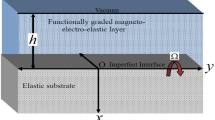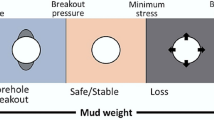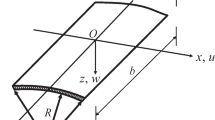Abstract
Current flow in homogeneous and layered conducting media is analyzed for the case where an axial conductor or cable is present. The cable is characterized by a specified axial impedance and is assumed to be infinite in length. Various configurations are chosen such as a current point source in an infinite, semi-infinite, and layered region where the cable is taken parallel to the interface(s). The resulting formulas for the potentials reduce to known cases in the absence of the cable. Using these formulations, we present some concrete calculated examples that are relevant to resistivity probing of perturbed homogeneous and layered structures. Only the two-electrode array is treated, but various cable orientations are considered. In general, it is found that a long axial conductor such as a bare cable will distort the potential distribution of the current in a major way. This leads to profound departures from the apparent resistivity curves calculated for idealized homogeneous and layered structures.
Similar content being viewed by others
References
Al'pin, L. M., Berdichevskii, G. A., Vedrintsev, G. A., andZagarmistr, A. M. (1966),Dipole Methods for Measuring Earth Resistivity (trans. by G. V. Keller), (Consultants Bureau, New York, 1966).
Grant, F. S., andWest, G. F. Interpretation Theory in Applied Geophysics, Chap. 14, (McGraw-Hill Publishing Co., New York, 1965).
Hill, D. A., andWait, J. R. (1977),Coupling between a dipole antenna and an infinite cable over an ideal ground plane. Radio Sci.12(2), 231–238.
Keller, G. V. (1968),Electrical prospecting for oil, Quart. Colorado School of Mines,63(2), 1–268.
Keller, G. V., andFrischknecht, F.,Electrical Methods in Geophysical Prospecting, Chap. 3, (Pergamon Press, New York and Oxford, 1966).
Kunetz, G. Principles of Direct Current Resistivity Prospecting, (Gebrüder Borntraeger, Berlin-Nikolassee, 1966).
Mooney, H. D. M., andWetzel, W. W.,The Potentials About a Point Electrode and Apparent Resistivity Curves for a Two, Three, and Four Layer Earth (Colwell Press, Inc., Minneapolis, 1956).
Stoyer, C. H., andWait, J. R. (1977),Resistivity probing of an ‘exponential’ earth with a homogeneous overburden, Geoexploration,15, 11–18.
Sunde, E. D.,Earth Conduction Effects in Transmission Systems, Chap. 2 (Dover Publications, New York, 1968).
Wait, J. R., andConda, A. M. (1958),On the measurement of ground conductivity at VLF, IRE Trans.,AP-6(3), 273–277.
Wait, J. R.,Electromagnetic Waves in Stratified Media, Chap. 2, 2nd Edition (Pergamon Press, 1970).
Wait, J. R., andHill, D. A. (1975),Propagation along a braided coaxial cable in a circular tunnel, IEEE Trans. on Microwave Theory and Tech.,MTT-23, 401–405.
Wheelon, A. D.,Tables of Summable Series and Integrals Involving Bessel Functions, p. 112 (Holden-Day, San Francisco, 1968).
Author information
Authors and Affiliations
Additional information
U.S. Government Work not subject to U.S. copyright.
Rights and permissions
About this article
Cite this article
Wait, J.R., Umashankar, K.R. Analysis of the earth resistivity response of buried cables. PAGEOPH 117, 711–742 (1978). https://doi.org/10.1007/BF00879975
Received:
Issue Date:
DOI: https://doi.org/10.1007/BF00879975




